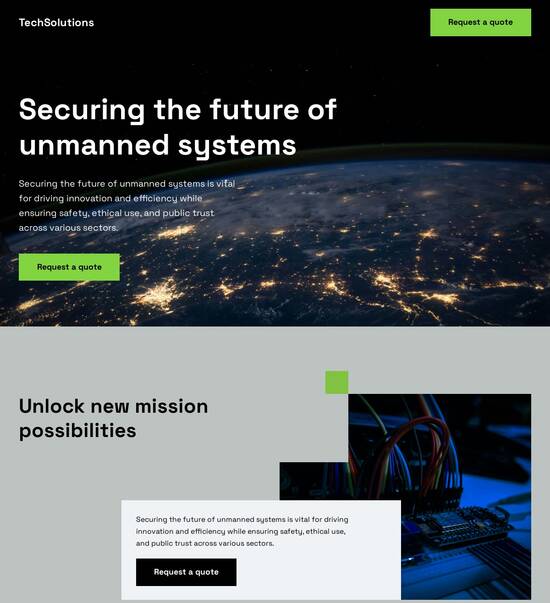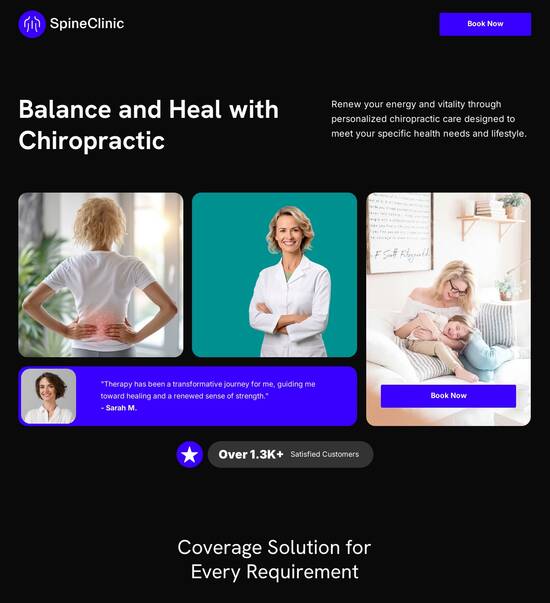
Web page template with interactive attendance form
Explore Similar TemplatesAbout template
Use web page templates with interactive attendance form and make your communications easy and transparent. Try our solution today.
Recommended templates

Easy to build without coding
With the intuitive drag-and-drop builder, anyone on your team can create high-converting pages without any knowledge of code or design. Make enhancements to your landing page with custom widgets using Javascript, HTML/CSS, or third-party scripts.

Multiple layouts for any industry and goal
Select from 500+ landing page layouts built to boost conversions across industry-specific scenarios. Customize them by adjusting fonts, adding images, and generating on-brand content with the AI assistant. Quickly scale with Instablocks® and Global Blocks that you can save, reuse, and update globally.

Loads fast and looks polished on any device
Every template is responsive, which means they present professionally on any device and load blazingly fast with our Thor Render Engine. You can also power them up with Google AMP technology to deliver an unparalleled mobile experience and drive higher conversions.

Robust analytics & experimentation
Get real-time updates and reporting across all your devices, showing the number of visitors, conversions, cost-per-visitor, and cost-per-lead. Launch AI-powered experiments, run A/B tests, and use heatmaps to analyze user behavior, then optimize your landing page to maximize conversions.







Easy to build without coding
With the intuitive drag-and-drop builder, anyone on your team can create high-converting pages without any knowledge of code or design. Make enhancements to your landing page with custom widgets using Javascript, HTML/CSS, or third-party scripts.
Multiple layouts for any industry and goal
Select from 500+ landing page layouts built to boost conversions across industry-specific scenarios. Customize them by adjusting fonts, adding images, and generating on-brand content with the AI assistant. Quickly scale with Instablocks® and Global Blocks that you can save, reuse, and update globally.
Loads fast and looks polished on any device
Every template is responsive, which means they present professionally on any device and load blazingly fast with our Thor Render Engine.
Robust analytics & experimentation
Get real-time updates and reporting across all your devices, showing the number of visitors, conversions, cost-per-visitor, and cost-per-lead. Launch AI-powered experiments, run A/B tests, and use heatmaps to analyze user behavior, then optimize your landing page to maximize conversions.
All the features you need to build attendance mark
Explore more featuresLearn how to build attendance website template free
Frequently asked questions about interactive attendance
Leading the way in building high-performing landing pages





An <H2> main heading that incorporates the keyword landing page optimization
Landing page optimization is crucial for increasing the conversion rates of your digital marketing campaigns. A platform like Instapage provides marketers with powerful tools to craft effective landing pages that resonate with visitors and drive measurable results. With over 100 templates tailored for high conversion, Instapage empowers users to quickly create, optimize, and personalize their landing experiences.
An Introduction to landing page optimization techniques
Effective landing page optimization focuses on enhancing user experience and ensuring that visitors take the desired actions. Strategies such as dynamic text replacement and A/B testing can significantly affect your campaign’s ROI.
- Dynamic text replacement: Tailor your landing pages to reflect the specific keywords users searched for, increasing relevance and engagement.
- A/B Testing: Experiment with different versions of your landing page; determine which elements contribute most to conversions.
- Heatmaps: Use heatmaps to analyze user interactions, identify areas of improvement, and understand user behavior on your landing pages.
An Step 1: Selecting the right template for your campaign
Choosing a template is one of the first steps in landing page creation. Instapage offers a wide assortment of high-quality templates designed to convert visitors into leads or customers.
An Step 2: Customize your landing page elements
Customize your selected template by including key elements that align with your campaign goals.
- Lead generation forms: Place forms strategically to easily capture user information without being intrusive.
- CTA buttons: Design compelling call-to-action buttons that compel visitors to engage and convert.
- Social proof: Add testimonials or case studies to build trust and credibility with your audience.
An Step 3: Optimize for performance
Once your landing page is set up, it’s time to fine-tune the page for optimal performance. This involves frequent testing and updates based on user feedback and performance analytics.
- Regular updates: Keep testing new elements or layouts periodically and refresh content to maintain relevance.
- Analytics tracking: Use analytics tools integrated into Instapage to gain insights into visitor behavior and page effectiveness.
- Feedback incorporation: Regularly collect and act on feedback from real visitors to enhance user experience.
In conclusion, landing page optimization is an ongoing process that requires strategy, testing, and adaptation. By leveraging the powerful features of Instapage, marketers can significantly enhance their landing pages and drive higher conversions.
Ready to elevate your digital marketing efforts? Start optimizing your landing pages with Instapage today to unlock the full potential of your campaigns!
People also ask about Web page template with interactive attendance form
Engaging the audience: The power of an interactive attendance form on web page templates
The importance of attendance tracking in today's digital landscape
Attendance tracking plays a pivotal role in the management of educational institutions and events. Knowing who is attending and who isn't can affect everything from resource allocation to event planning. For educators, monitoring attendance is crucial for assessing student engagement and performance. For businesses and event organizers, attendance figures can directly influence marketing strategies and budgeting decisions.
Accurate attendance tracking supports organizational goals by enabling better decision-making based on comprehensive data. When attendance records are maintained accurately, institutions can identify trends, such as peak attendance times or demographics of those attending, allowing for targeted outreach and enhanced engagement.
The evolution from manual attendance tracking methods—such as paper rolls and sign-in sheets—to digital solutions has transformed the effectiveness and accuracy of this task. Modern web solutions incorporate interactive attendance forms, streamlining the process and significantly reducing the margin of error.
Crafting a web page template: The backbone of interaction
Web page templates provide a foundational layout that simplifies the creation of interactive attendance forms. A web page template is essentially a pre-designed framework that allows users to quickly build their web pages without needing extensive coding knowledge. These templates enhance user engagement by ensuring that all elements are cohesive and visually appealing.
Using pre-designed templates offers several benefits for organizations seeking to implement attendance tracking systems. Firstly, they significantly reduce the time required to develop functional pages. Secondly, templates encourage consistency in design, contributing to a seamless user experience. This consistency is critical for organizations that wish to present a professional and cohesive brand identity online.
Furthermore, mobile responsiveness is a major advantage of modern templates. With the rise of mobile internet usage, ensuring that attendance forms are accessible and operational on various devices is essential for maximizing registration potential.
Speed and efficiency: Get forms up and running quickly.
Consistency: Maintain a uniform look and feel across platforms.
Mobile responsiveness: Cater to users on any device.
The customizability of web page templates offers users the flexibility to modify layouts and design elements based on their specific requirements. This functional diversity ensures that different organizations can align the attendance forms with their operational styles and branding.
The mechanics of an interactive attendance form
An effective interactive attendance form incorporates several critical elements. Essential fields include name and contact information, date, and event details. These components not only facilitate accurate record-keeping but also enhance user engagement by making it easier for attendees to provide necessary information.
Additionally, implementing check-in/check-out functionality allows users to indicate their presence dynamically. This feature provides real-time data on attendance, making it easier for organizations to manage event logistics.
To boost user experience, interactive features are crucial. Dropdown menus streamline event selection processes, allowing users to choose from predefined options. Real-time validation checks users’ input as they fill out forms, minimizing errors significantly. Moreover, utilizing user-friendly captchas can prevent spam submissions and enhance the integrity of data collected.
Name and contact information fields: Essential for tracking attendance.
Date and event details: Key for clarity and context.
Check-in/check-out functionality: Tracks attendance dynamically.
Visual design elements also play a significant role in making forms appealing. Strategic use of color can influence attendance rates—warm colors might draw users in while calmer tones could instill a sense of reliability. Including relevant images and icons enhances the form's visual attractiveness and aligns it better with the branding of the host organization.
Behind the scenes: Data tracking & management
Gathering data from attendance forms is instrumental for various reasons. Firstly, it helps organizations measure attendance trends over time, revealing insights that could inform future events. Understanding attendee demographics allows organizations to tailor their marketing and event strategies more effectively, ensuring they meet the needs of their audience.
To manage this data efficiently, integrating attendance forms with Customer Relationship Management (CRM) systems and other applications is crucial. Such integrations enable automated sorting and filtering of data, rendering it easier to compile reports and analyze trends.
Utilizing analytics tools can enhance organizational insights further. These tools allow for nuanced visibility into various aspects of attendance, including detailed tracking of student attendance versus event attendance. Reporting functions enable organizations to generate comprehensive attendee statistics, facilitating improved decision-making.
Measuring attendance trends: Understand patterns over time.
Understanding attendee demographics: Tailor strategies accordingly.
Seamless integrations: Enhancing functionality with third-party apps
Integrating attendance forms with other platforms enhances their utility significantly. Firstly, syncing forms with calendars enables effortless event management by automatically updating participants of changes or reminders. Efforts for marketing campaigns can also be improved by connecting these forms with email marketing tools, ensuring that follow-ups are timely and relevant.
User stories reveal that businesses have experienced improved engagement and increased RSVP rates through strategic integrations. These examples highlight the effectiveness of considering the user journey as attendees navigate through registration and confirmation processes.
Setting up integrations can be streamlined. Choosing the right tools that complement existing systems is the first step. After selection, configuring API connections allows for smooth data flow between platforms while maintaining data integrity and accuracy.
Syncing with calendars: Enable quick and easy updates.
Connecting with email marketing tools: Enhance follow-up capabilities.
Tailoring plans and templates for diverse use cases
Understanding the varying needs of different organizations is essential in designing effective attendance tracking solutions. For example, educational institutions demand templates that not only track presence but also monitor student performance. In contrast, corporate events may require templates that facilitate networking and engagement.
Recommended templates for different scenarios ensure that each use case is addressed appropriately. For classroom attendance systems, templates can include fields for subject names and instructor details. Conference check-in forms should accommodate group registrations and social media handles to enhance networking. Webinar participation forms might leverage features like automated reminders for optimal attendance.
By offering customizable plan features, organizations optimize their return on investment. Flexible pricing models based on scale ensure that even smaller institutions can afford effective attendance solutions. Furthermore, tiered templates based on functionality allow organizations to choose specific features they need without overspending.
Classroom attendance systems: Track students efficiently.
Conference check-in forms: Foster networking opportunities.
Webinar participation forms: Improve online engagement.
User-centric guides: Learning to maximize features
Creating attendance forms is an actionable process that can be simplified through a step-by-step guide. Starting with initial setup and customization, organizations decide on layout, fields, and brand alignments that resonate with their objectives. Following this, testing the form before its launch is vital to eliminate any issues that may affect user experience.
It is essential to monitor attendance in real time, especially during high-traffic events. Preparations should include load testing the forms to ensure they can handle the anticipated influx of registrations. Providing mobile access is beneficial, as many users prefer completing forms on their phones.
Collecting feedback post-event can drive continuous improvement. Gathering attendee insights on the registration experience allows organizations to refine their templates and processes for future events, creating a cycle of ongoing enhancement.
Initial setup and customization: Tailor forms for specific needs.
Testing your form before launch: Ensure smooth operation.
Preparing for high-traffic events: Optimize load capacity.
Measuring success: KPIs and outcomes from using interactive forms
Key performance indicators (KPIs) play a crucial role in assessing the effectiveness of attendance forms. Completion rates indicate how many users successfully filled out the forms without encountering obstacles, while the accuracy of collected data reflects the reliability of the information garnered through these forms.
Real-life success stories from businesses and educational institutions exemplify the transformative impact of interactive attendance forms. Organizations often compare attendance rates before and after implementation, revealing that streamlined processes lead to higher participation rates. Moreover, an analysis of the return on investment (ROI) highlights the time and resources saved through automation and efficient data management.
Looking ahead, emerging trends in attendance tracking technology suggest continual evolution. Tools that employ artificial intelligence and machine learning to predict attendance patterns and enhance user experience are on the rise. Organizations that adapt to these innovations will stay ahead in managing their attendance effectively.
Completion rate: Evaluate user engagement.
Accuracy of collected data: Ensure reliable information.
The future of attendance forms in a connected world
Anticipating user needs and market shifts is essential in the further development of attendance tracking solutions. Innovations on the horizon, such as augmented reality experiences, could personalize user interactions during events. Such advancements could vastly enhance engagement levels by providing immersive experiences that traditional forms cannot.
However, as organizations become more data-driven, the significance of data privacy and compliance cannot be overstated. Companies must be proactive in safeguarding attendee information and ensuring that all data collection practices align with regional regulations to maintain trust and transparency.
Ready to skyrocket conversions?
Supercharge your ad campaigns with high-performing landing pages
Get started














